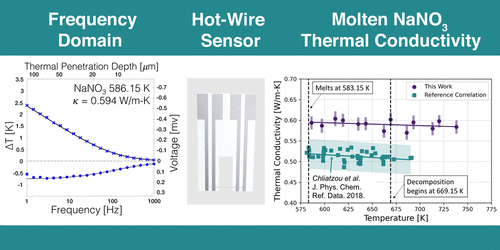当前位置:
X-MOL 学术
›
J. Chem. Eng. Data
›
论文详情
Our official English website, www.x-mol.net, welcomes your
feedback! (Note: you will need to create a separate account there.)
Frequency-Domain Hot-Wire Measurements of Molten Nitrate Salt Thermal Conductivity
Journal of Chemical & Engineering Data ( IF 2.0 ) Pub Date : 2020-12-07 , DOI: 10.1021/acs.jced.0c00621 Andrew Z. Zhao 1 , Matthew C. Wingert 1 , Javier E. Garay 1
Journal of Chemical & Engineering Data ( IF 2.0 ) Pub Date : 2020-12-07 , DOI: 10.1021/acs.jced.0c00621 Andrew Z. Zhao 1 , Matthew C. Wingert 1 , Javier E. Garay 1
Affiliation

|
The thermal conductivity of liquids has traditionally been determined by measuring either the steady-state temperature gradient or time-dependent temperature rise in a sample due to an applied heat flux. The transient hot-wire method has become the standard for measuring liquid thermal conductivity; in this method, direct current Joule heats a long, thin wire immersed in a liquid sample, and the measured temperature rise over a particular time interval is fit to a heat transfer model to extract the thermal conductivity of the liquid. However, in the high-temperature environments of molten salts, long metal wires are vulnerable to corrosion, and convection errors are magnified in larger volumes of molten salts. Here, we utilize a new frequency-domain, corrosion-resistant, short hot-wire technique (sensor and model) to measure the thermal conductivity of molten NaNO3 (2.78% standard uncertainty), KNO3 (2.38% standard uncertainty), and a solar salt mixture (2.66% standard uncertainty). Operating in the frequency domain and utilizing a full 3D model allows the use of short sensor wires, reducing the total contact area to minimize corrosion, and the use of small sample volumes, mitigating convection errors. An alternating current at varying frequencies Joule heats a short platinum wire sensor (6.5 mm), which is protected by a 1.6 μm-thick Al2O3 coating, submerged in molten salt. The frequency-dependent temperature response of the sensor surrounded by salt is measured and fit to a 3D thermal model to obtain the thermal conductivity of the molten salt. Together, the new sensor design and 3D model keep the probed molten salt volume below 1 μL. Our frequency-domain measurements show an ∼11 to 15% higher thermal conductivity of molten nitrate salts than the current reference correlations made from steady-state and time-domain measurements.
中文翻译:

硝酸盐熔盐热导率的频域热线测量
传统上,液体的热导率是通过测量样品中的稳态温度梯度或由于施加的热通量而随时间变化的温度升高来确定的。瞬态热线法已成为测量液体导热系数的标准方法。在这种方法中,直流焦耳加热浸入液体样品中的细长丝,并且在特定时间间隔内测得的温度升高适合传热模型,以提取液体的热导率。然而,在熔融盐的高温环境中,长金属线容易受到腐蚀,并且在较大体积的熔融盐中对流误差会放大。在这里,我们利用了新的频域,耐腐蚀,3(2.78%标准不确定度),KNO 3(2.38%标准不确定度)和日盐混合物(2.66%标准不确定度)。在频域中运行并利用完整的3D模型,可以使用短传感器线,减小总接触面积以最大程度地减少腐蚀,并使用小样本量,从而减轻对流误差。交流电以不同的频率焦耳加热一个短的铂金线传感器(6.5毫米),该传感器由厚度为1.6μm的Al 2 O 3保护涂层,浸入熔融盐中。测量被盐包围的传感器的频率相关温度响应,并将其拟合到3D热模型中以获得熔融盐的导热率。新的传感器设计和3D模型一起可以使探测到的熔融盐体积保持在1μL以下。我们的频域测量结果表明,熔融硝酸盐的热导率比稳态和时域测量得到的当前参考相关性高11至15%。
更新日期:2021-01-14
中文翻译:

硝酸盐熔盐热导率的频域热线测量
传统上,液体的热导率是通过测量样品中的稳态温度梯度或由于施加的热通量而随时间变化的温度升高来确定的。瞬态热线法已成为测量液体导热系数的标准方法。在这种方法中,直流焦耳加热浸入液体样品中的细长丝,并且在特定时间间隔内测得的温度升高适合传热模型,以提取液体的热导率。然而,在熔融盐的高温环境中,长金属线容易受到腐蚀,并且在较大体积的熔融盐中对流误差会放大。在这里,我们利用了新的频域,耐腐蚀,3(2.78%标准不确定度),KNO 3(2.38%标准不确定度)和日盐混合物(2.66%标准不确定度)。在频域中运行并利用完整的3D模型,可以使用短传感器线,减小总接触面积以最大程度地减少腐蚀,并使用小样本量,从而减轻对流误差。交流电以不同的频率焦耳加热一个短的铂金线传感器(6.5毫米),该传感器由厚度为1.6μm的Al 2 O 3保护涂层,浸入熔融盐中。测量被盐包围的传感器的频率相关温度响应,并将其拟合到3D热模型中以获得熔融盐的导热率。新的传感器设计和3D模型一起可以使探测到的熔融盐体积保持在1μL以下。我们的频域测量结果表明,熔融硝酸盐的热导率比稳态和时域测量得到的当前参考相关性高11至15%。











































 京公网安备 11010802027423号
京公网安备 11010802027423号